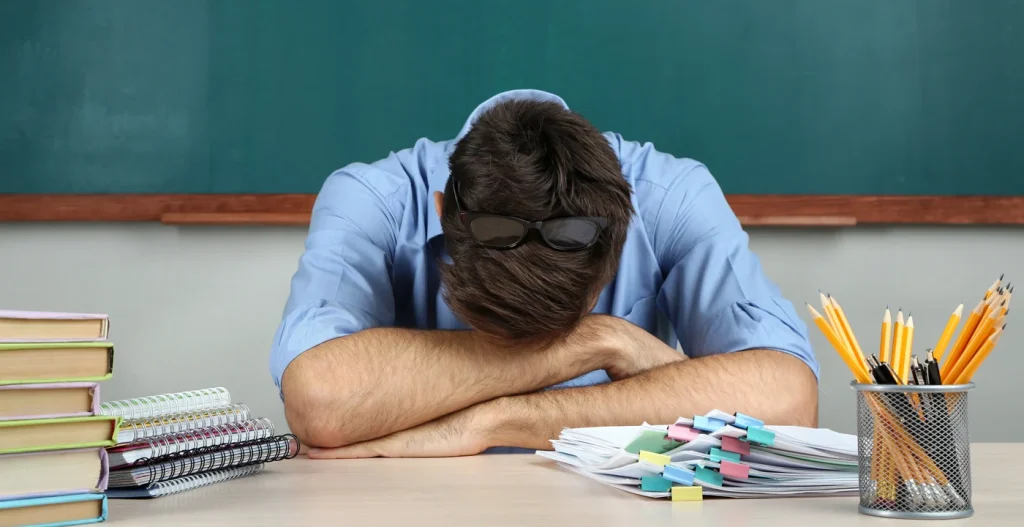I still remember the moment it hit me. It was a Thursday afternoon, 15 minutes after dismissal. My classroom looked like a tornado had passed through, my inbox was a warzone, and my coffee was still sitting full on my desk—cold and untouched since 7 a.m. I sat down and realized, I’m completely drained… and it’s only week six.
Teacher burnout doesn’t happen overnight. It builds—slowly, quietly—until you’re running on fumes, wondering if it’s just you. But it’s not just you. It’s happening everywhere.
Let’s talk about it. For real.
What Is Teacher Burnout, Really?

Burnout isn’t just stress. It’s chronic emotional, mental, and physical exhaustion caused by prolonged work-related stress—often without enough support, recognition, or recovery time.
For teachers, burnout can look like:
-
Constant fatigue, even after a full night’s sleep
-
Feeling detached from students or colleagues
-
Losing motivation or passion for teaching
-
Increased irritability or cynicism
-
Physical symptoms knowledge like headaches, insomnia, or anxiety
It’s that feeling of “I can’t keep doing this”—even if you love your students and love to teach.
Why Teachers Burnout: The Common Causes
Let’s be honest—teaching is one of the most emotionally demanding jobs out there. You’re not just delivering content. You’re managing behaviors, tracking data, communicating with families, adapting lessons, attending meetings, and often being a counselor on top of it all.
Here are some of the biggest contributors to teacher stress:
📚 Overwhelming Workload
Grading, lesson planning, reports, documentation… it doesn’t stop when the bell rings. Many teachers work 50–60+ hours a week.
🎯 Unrealistic Expectations
From admin, parents, the system, and sometimes ourselves. Always being told to do more—with fewer resources.
💻 Lack of Autonomy
Being micromanaged, expected to follow rigid curriculum scripts, or feeling like your creativity is constantly boxed in.
❌ Insufficient Support
Little emotional support, few planning breaks, and not enough professional development around self-care and wellness.
💔 Emotional Exhaustion
Dealing with trauma, student needs, and behavioral issues every day without space to process it all.
When those things pile up with no time to recover, burnout isn’t just possible—it’s inevitable.
What Burnout Feels Like (And How to Spot It Early)
Everyone experiences burnout differently, but some early signs include:
-
Snapping over small things
-
Dreading the next school day—even on Sundays
-
Zoning out during lessons or meetings
-
Feeling like you’re never “caught up”
-
Forgetting why you started teaching in the first place
I ignored those signs for a long time. I told myself I just needed a better planner or a weekend to catch up. But burnout isn’t a to-do list problem. It’s a capacity problem. You can’t pour from an empty cup.
How to Address Teacher Burnout: Real, Practical Strategies
Here’s what helped me—and what I’ve seen help others. None of these are instant fixes, but they’re steps toward feeling like you again.
1. Set Boundaries Without Guilt
You can care deeply and still protect your time.
Say no to taking work home every night. Set an end-of-day time, and stick to it. You deserve rest, not just productivity.
2. Take “Micro-Breaks” During the Day
Even 2–5 minutes to breathe, stretch, or sit in silence can reset your brain. I started keeping a “burnout box” at my desk—just fidgets, tea, or calming quotes. It sounds silly, but it helped.
3. Talk to Someone
Find a fellow teacher you trust. Or a mentor. Or a counselor. Burnout grows in isolation. Talking about it can make a huge difference.
4. Use Your Sick Days
Mental health is health. You’re not weak for needing a day to rest or regroup. Use it. No guilt.
5. Celebrate the Small Wins
Did a student finally get that concept? Did you make it through a tough day with grace? That matters. Keep a “wins” journal. It helps on the rough days.
6. Ask for Help
You’re not meant to carry everything alone. Delegate when you can. Speak up about what’s not working. You don’t have to be the hero of the whole school.
What Schools and Leaders Can Do
Teacher wellness isn’t just an individual responsibility. Systems need to step up too.
Here’s what truly supportive schools do:
-
Protect planning time (no last-minute meetings every free period)
-
Normalize mental health days
-
Provide coaching without judgment
-
Encourage team collaboration (not competition)
-
Listen to teacher feedback
Burnout isn’t a personal failure—it’s often a symptom of broken systems. And if we want great teachers to stay, we have to build better environments for them to thrive.
Final Thoughts: You’re Not Alone, and You’re Not Failing
If you’re a teacher reading this and feeling like you’re barely holding on—I see you.
Burnout doesn’t mean you’re not a good teacher. It doesn’t mean you don’t care. It means you’ve been doing too much, for too long, with too little support.
You deserve space to breathe. You deserve systems that protect your energy, not drain it. And most of all—you deserve to remember why you fell in love with teaching in the first place.
Let’s not wait until we’re completely burned out to take care of ourselves. You matter. Not just as a teacher—but as a human being.
Love great food and entertaining guests? Visit Decology for delicious recipes, hosting tips, and lifestyle inspiration! – https://decology.com



